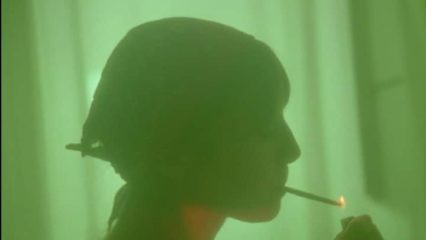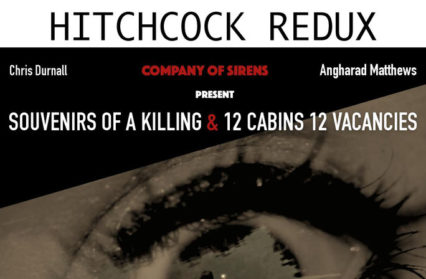When cinema and real life events collide, can one become an artistic metaphor for the other? In Hitchcock Redux, theatre maker Chris Durnall reflects on the connections between his own at times traumatic personal life and the renowned Hitchcock films which influenced the creation of his latest plays.
This May, Twelve Cabins Twelve Vacancies and Souvenirs of a Killing will be performed together as a new work, Hitchcock Redux. The two pieces, the first of which was produced in a very short run in summer 2019, are based on my own memories. They are connected to grief and are indelibly linked to famous Hitchcock films. The events leading to the creation of Twelve Cabins Twelve Vacancies have been detailed in an earlier article in Wales Arts Review. The backstory to Souvenirs of a Killing is somewhat different, but still linked to personal experience: in the early 1970s a friend was taken from her home and kept in dreadful circumstances that led eventually to her death. Around this time, there was a weekly film club run locally that we used to regularly attend. One of the films we saw was Vertigo. In my mind, the event has always been coloured by the artistry of that movie. The films themselves are captured in time but memory is selective and perhaps not to be trusted. Given that the central event of each piece was cataclysmic at the time of its occurrence, why have the pieces been linked with two of Hitchcock’s most famous films? Does their inclusion help to soften the impact of the memory, or to reinforce it?
 The answer perhaps lies in the nature of memory itself. The central event of each piece from Hitchcock Redux occurred a very long time ago; this lengthy timespan between the events and their recall creates a sense of objectivity while also removing forgotten detail (both narrative and emotional). When looking back through visual and sensory images, any pain of consequent grief is filtered through the lens we ourselves choose to add: the memory therefore becomes cinematic and photographic.
The answer perhaps lies in the nature of memory itself. The central event of each piece from Hitchcock Redux occurred a very long time ago; this lengthy timespan between the events and their recall creates a sense of objectivity while also removing forgotten detail (both narrative and emotional). When looking back through visual and sensory images, any pain of consequent grief is filtered through the lens we ourselves choose to add: the memory therefore becomes cinematic and photographic.
The films Psycho and Vertigo were not chosen at random. Both are films I was watching at the time of and within close proximity to each event. They have become so inextricably linked with those moments that they have become artistic metaphors for the events themselves. Through directing productions, I’ve become used to acknowledging and identifying connections between plays and the personal. These connections provide a necessary key to unlocking the depth and rationale hidden within a piece. A study of the two films in question demonstrated in my mind clear connections between the events themselves and the filmic artwork. So, in creating the piece I looked to make these connections, knowing and trusting they would be found.
The opening scene from Vertigo shows a rooftop chase leading to Scottie (James Stewart) failing to save a colleague who falls to his death. This is from Souvenirs of a Killing:
I can see you,
reaching down and someone is reaching her hand up to
you, she’s falling, falling from a great height and reaching
out to you but you let her fall, can you hear her calling out
your name? Close your eyelids. See, you
never saw her land did you, you never saw her land.
Perhaps the reason these films and other classic works of art, whether in the medium of music, literature or the visual, continue to resonate and support several replayings, is that each of us identifies a link to our own life, however minute and tenuous that link may be. I believe that these connections reveal themselves in the detail: a walk, a colour or tone, a smile or movement of a hand. This minutia provides direct visual communication that lies beyond words. Something, direct, basic and primitive.
Vertigo, for instance, provides several visual connections to the events in Souvenirs of a Killing that become increasingly clear. I watched the film many years ago and only now the tunnel Hitchcock focuses on in Kim Novak’s hair translates into the underground prison that forms the climax of the narrative of Souvenirs of a Killing.
Madeline sits and studies the portrait in the gallery.
The painting of Carlotta Valdes.
We see the back of her head and her hair forms a spiral
that takes the form of a tunnel or a drain.
We enter the tunnel. It’s dark, cold and damp.
It smells stale, of neglect. We hear a sound, a whimper.
It’s tangible and we recognize the figure hunched on the
ledge… as Madeline shakes her hair loose.
In Twelve Cabins Twelve Vacancies, the obsessive link between Norman Bates and his mother provides a more obvious comparison with real events; however, it’s in the figure of Marion Crane herself that things really connect. There is a startling visual comparison, likewise with phrases and patterns of speech. Immediately after the shower murder, the eye becomes a vortex spiralling down into a drain. The glass of milk and the cheese sandwiches taken in Norman’s parlour are reflected and identified in the real time narrative, and the past itself is monochrome.
There is a special magic at work in the arts and that magic draws us like a magnet; when the personal and the everyday become the general, it provides a cocktail of wonder that is hard to forget or ignore.
She turns and smiles a steady collected smile while
reaching back she lets her hair fall. “Hangsaman” she said
as the flowers form a noose around her throat.
By San Francisco bridge a figure drops into the water
(Souvenirs of a Killing)
Hitchcock Redux (Souvenirs of a Killing and Twelve Cabins Twelve Vacancies) is (subject to COVID restrictions) due to be performed at Chapter May 3rd – 9th. To keep up to date, visit the Company of Sirens website.












